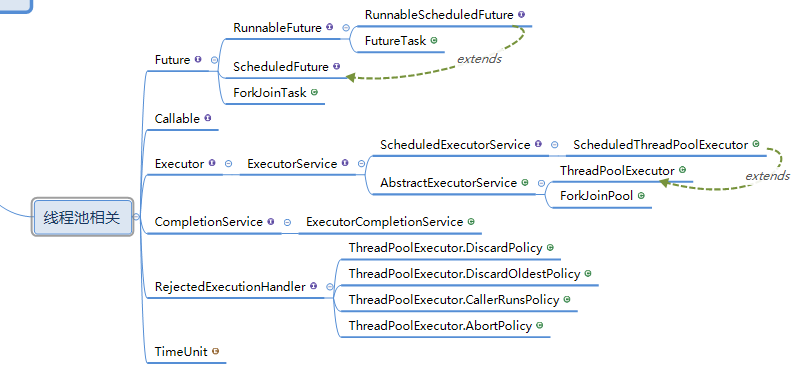线程池相关

源码:
package java.util.concurrent;
public interface ScheduledExecutorService extends ExecutorService {
//创建并执行在给定延迟后启用的一次性操作
public ScheduledFuture<?> schedule(Runnable command,long delay, TimeUnit unit);
//创建并执行在给定延迟后启用的 ScheduledFuture
public <V> ScheduledFuture<V> schedule(Callable<V> callable,long delay, TimeUnit unit);
//创建并执行一个在给定初始延迟后首次启用的定期操作,后续操作具有给定的周期
//在initialDelay后开始执行,然后之后每隔period执行一次
public ScheduledFuture<?> scheduleAtFixedRate(Runnable command,long initialDelay,long period,TimeUnit unit);
//创建并执行一个在给定初始延迟后首次启用的定期操作,随后在每一次执行终止和下一次执行开始之间都存在给定的延迟
public ScheduledFuture<?> scheduleWithFixedDelay(Runnable command,long initialDelay,long delay,TimeUnit unit);
}
接口 ScheduledExecutorService
所有超级接口:
所有已知实现类:
schedule 方法使用各种延迟创建任务,并返回一个可用于取消或检查执行的任务对象。scheduleAtFixedRate 和 scheduleWithFixedDelay 方法创建并执行某些在取消前一直定期运行的任务。
用 Executor.execute(java.lang.Runnable) 和 ExecutorService 的 submit 方法所提交的命令,通过所请求的 0 延迟进行安排。
schedule 方法中允许出现 0 和负数延迟(但不是周期),并将这些视为一种立即执行的请求。
所有的 schedule 方法都接受相对 延迟和周期作为参数,而不是绝对的时间或日期。将以 Date 所表示的绝对时间转换成要求的形式很容易。
例如,要安排在某个以后的 Date 运行,可以使用:schedule(task, date.getTime() - System.currentTimeMillis(), TimeUnit.MILLISECONDS)。
注意,由于网络时间同步协议、时钟漂移或其他因素的存在,因此相对延迟的期满日期不必与启用任务的当前 Date 相符。
Executors 类为此包中所提供的 ScheduledExecutorService 实现提供了便捷的工厂方法。
用法示例
以下是一个带方法的类,它设置了 ScheduledExecutorService ,在 1 小时内每 10 秒钟蜂鸣一次:
package com.thread;
import java.util.concurrent.Executors;
import java.util.concurrent.ScheduledExecutorService;
import java.util.concurrent.ScheduledFuture;
import static java.util.concurrent.TimeUnit.SECONDS;
class BeeperControl {
private final ScheduledExecutorService scheduler = Executors.newScheduledThreadPool(1);
public void beepForAnHour() {
final Runnable beeper = new Runnable() {
public void run() {
System.out.println("beep");
}
};
final ScheduledFuture<?> beeperHandle = scheduler.scheduleAtFixedRate(beeper, 10, 10, SECONDS);//创建一个ScheduledFuture 对象实例
scheduler.schedule(new Runnable() {
public void run() {
beeperHandle.cancel(true);//执行过程允许中断
}
}, 60 * 60, SECONDS);
}
}从接口 java.util.concurrent.ExecutorService 继承的方法
awaitTermination, invokeAll, invokeAll, invokeAny, invokeAny, isShutdown, isTerminated, shutdown, shutdownNow, submit, submit, submit
从接口 java.util.concurrent.Executor 继承的方法
execute
schedule
ScheduledFuture<?> schedule(Runnable command,long delay, TimeUnit unit)
创建并执行在给定延迟后启用的一次性操作。
参数:
command - 要执行的任务
delay - 从现在开始延迟执行的时间
unit - 延迟参数的时间单位
返回:
表示挂起任务完成的 ScheduledFuture,并且其 get() 方法在完成后将返回 null
抛出:
RejectedExecutionException - 如果无法安排执行该任务
NullPointerException - 如果 command 为 null
schedule
<V> ScheduledFuture<V> schedule(Callable<V> callable, long delay, TimeUnit unit)
创建并执行在给定延迟后启用的 ScheduledFuture。
参数:
callable - 要执行的功能
delay - 从现在开始延迟执行的时间
unit - 延迟参数的时间单位
返回:
可用于提取结果或取消的 ScheduledFuture
抛出:
RejectedExecutionException - 如果无法安排执行该任务
NullPointerException - 如果 callable 为 null
scheduleAtFixedRate
ScheduledFuture<?> scheduleAtFixedRate(Runnable command,long initialDelay,long period,TimeUnit unit)
创建并执行一个在给定初始延迟后首次启用的定期操作,后续操作具有给定的周期;也就是将在 initialDelay 后开始执行,然后在 initialDelay+period 后执行,接着在 initialDelay + 2 * period 后执行,依此类推。如果任务的任何一个执行遇到异常,则后续执行都会被取消。否则,只能通过执行程序的取消或终止方法来终止该任务。如果此任务的任何一个执行要花费比其周期更长的时间,则将推迟后续执行,但不会同时执行。
参数:
command - 要执行的任务
initialDelay - 首次执行的延迟时间
period - 连续执行之间的周期
unit - initialDelay 和 period 参数的时间单位
返回:
表示挂起任务完成的 ScheduledFuture,并且其 get() 方法在取消后将抛出异常
抛出:
RejectedExecutionException - 如果无法安排执行该任务
NullPointerException - 如果 command 为 null
IllegalArgumentException - 如果 period 小于等于 0
scheduleWithFixedDelay
ScheduledFuture<?> scheduleWithFixedDelay(Runnable command,long initialDelay,long delay,TimeUnit unit)
创建并执行一个在给定初始延迟后首次启用的定期操作,随后,在每一次执行终止和下一次执行开始之间都存在给定的延迟。如果任务的任一执行遇到异常,就会取消后续执行。否则,只能通过执行程序的取消或终止方法来终止该任务。
参数:
command - 要执行的任务
initialDelay - 首次执行的延迟时间
delay - 一次执行终止和下一次执行开始之间的延迟
unit - initialDelay 和 delay 参数的时间单位
返回:
表示挂起任务完成的 ScheduledFuture,并且其 get() 方法在取消后将抛出异常
抛出:
RejectedExecutionException - 如果无法安排执行该任务
NullPointerException - 如果 command 为 null。
IllegalArgumentException - 如果 delay 小于等于 0